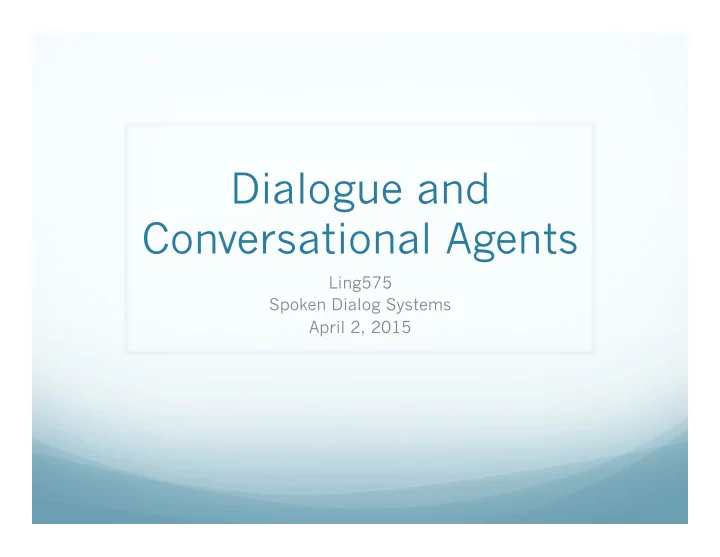

Dialogue and Conversational Agents Ling575 Spoken Dialog Systems April 2, 2015
Roadmap Dialog and Dialog Systems Facets of Conversation: Turn-taking Speech Acts Cooperativity Grounding Spoken Dialogue Systems: Pipeline Architecture Finite-State, Frame-based, Information State Systems Evaluation
Dialog Example
Travel Planning
AT&T’s How May I Help You?
ItSpoke Tutoring System
Dialogue is Different Two or more speakers Primary focus on speech Issues in multi-party spoken dialogue Turn-taking – who speaks next, when? Collaboration – clarification, feedback,… Disfluencies Adjacency pairs, dialogue acts
Conversations and Conversational Agents Conversation: First and often most common form of language use Context of language learning and use Goal: Describe, characterize spoken interaction Enable automatic recognition, understanding Conversational agents: Spoken dialog systems, spoken language systems Interact with users through speech Tasks: travel arrangements, call routing, planning
Conversation Intricate, joint activity Constructed from consecutive turns Joint activity between speakers, hearer Involves inferences about intended meaning SDS: simpler, but hopefully consistent
Turn-Taking Multi-party discourse Need to trade off speaker/hearer roles Interpret reference from sequential utterances When? End of sentence? No: multi-utterance turns Silence? No: little silence in smooth dialogue:< 250ms Gaps less than actual sentence planning time - anticipate When other starts speaking? No: relatively little overlap face-to-face: ~5%
Turn-taking: Who & How At each TRP in each turn (Sacks 1974) If speaker has selected A to speak, A must take floor If speaker has selected no one to speak, anyone can If no one else takes the turn, the speaker can Selecting speaker A: By explicit/implicit mention: What about it, Bob? By gaze, function Selecting others: questions, greetings, closing (Traum et al., 2003)
Turns and Structure Some utterances select others: Adjacency pairs: Greeting – Greeting, Question – Answer, Compliment – Downplayer Silence ‘dispreferred’ within adjacency pair A: Is there something bothering you or not? (1.0) A: Yes or No? (1.5) A: Eh. B: No.
Turn-taking in HCI Human turn end: Detected by 250ms (or longer) silence System turn end: Signaled by end of speech Indicated by any human sound Barge-in Continued attention: No signal Design problems create ambiguous silences Problematic for SDS users (Stifelman et al., 1993), (Yankelovich et al, 1995)
Utterances as 3 Act Types Locutionary act: utterance with some meaning “You can’t do that!” Illocutionary act: Act of asking, promising, answering, in utterance Protesting Perlocutionary act: Production of effects on feeling, beliefs of addressee Intend to prevent doing some action Types: assertives, directives, commissives, expressives, declarations
The 3 levels of act revisited Locutionary Illocutionary Perlocutionary Force Force Force Can I have the Question Request Intent: You give rest of your me sandwich sandwich? I want the rest Declarative Request Intent: You give of your me sandwich sandwich Give me your Imperative Request Intent: You give sandwich! me sandwich 3/31/15 15 Speech and Language Processing -- Jurafsky and Martin
Collaborative Communication Speaker tries to establish and add to “ common ground ” – “ mutual belief ” Presumed a joint, collaborative activity Make sure “ mutually believe ” the same thing Hearer must ‘ground’ speaker’s utterances Indicate heard and understood
Closure Principle of closure: Agents performing an action require evidence of successful performance Also important to indicate failure or understanding Non-speech closure: Push elevator button à Light turns on Two step process: Presentation (speaker) Acceptance (listener)
Degrees of Grounding Weakest to strongest Continued attention: Silence implies consent Next relevant contribution Acknowledgment: Minimal response, continuer: yeah, uh-huh, okay; great Demonstrate: Indicate understanding by reformulation, completion Display: Repeat all or part
Dialog Example
Grounding Display: C: I need to travel in May. A: And what day in May did you want to travel? Acknowledgment + Next relevant contribution: And what day in May did you want to travel? And you are flying into what city? And what time would you like to leave Pittsburgh?
Travel Planning
Grounding in HCI Key factor in HCI: Users confused if system fails to ground, confirm (Stifelman et al., 1993), (Yankelovich et al, 1995) S: Did you want to review some more of your profile? U: No. S: What’s next? S: Did you want to review some more of your profile? U: No. S: Okay, what’s next?
Conversational Implicature Meaning more than just literal contribution A: And, what day in May did you want to travel? C: OK uh I need to be there for a meeting the 12-15 th Appropriate? Yes Why? Inference guides
Grice ’ s Maxims Cooperative principle: Tacit agreement b/t conversants to cooperate Grice ’ s Maxims Quantity: Be as informative as required Quality: Be truthful Don ’ t lie, or say things without evidence Relevance: Be relevant Manner: “ Be perspicuous ” Don ’ t be obscure, ambiguous, prolix, or disorderly
Relevance Client: I need to be there for a meeting that ’ s from the 12th to the 15th Hearer thinks: Speaker is following maxims, would only have mentioned meeting if it was relevant. How could meeting be relevant? If client meant me to understand that he had to depart in time for the mtg. 3/31/15 25 Speech and Language Processing -- Jurafsky and Martin
Quantity A:How much money do you have on you? B: I have 5 dollars Implication: not 6 dollars A: Did you do the reading for today ’ s class? B: I intended to Implication: No B ’ s answer would be true if B intended to do the reading AND did the reading, but would then violate maxim 3/31/15 26 Speech and Language Processing -- Jurafsky and Martin
From Human to Computer Conversational agents Systems that (try to) participate in dialogues Examples: Directory assistance, travel info, weather, restaurant and navigation info Issues: Limited understanding: ASR errors, interpretation Computational costs
Dialogue System Architecture
Recommend
More recommend